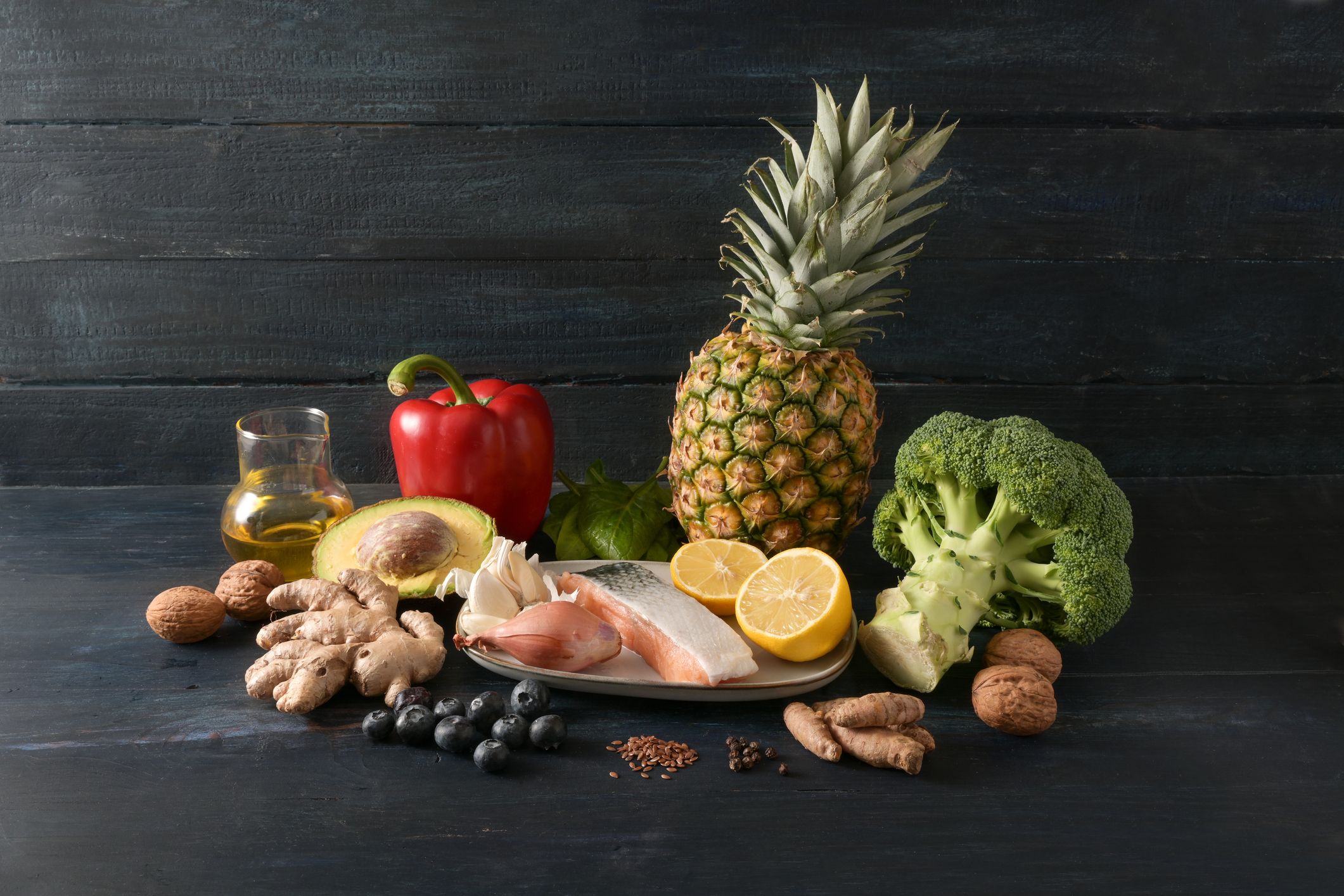In a world where we’re bombarded by media with mixed messages, it can be easy to get lost and confused. What is an anti-inflammatory diet? Turmeric, garlic, papaya and other tasty, Instagram-friendly foods are frequently labelled as ‘anti-inflammatory’ but does the scientific evidence stack up? Dr Linia Patel answers the question.
A couple of months ago, one of the sports medicine doctors I work closely with asked me to write a paragraph on ‘anti-inflammatory diet’. As a dietitian with over 15 years of clinical experience, it dawned on me that I have never explicitly written an article/blog about what an anti-inflammatory diet is – an interesting observation, given that in my clinical practice it’s the type of eating pattern I encourage clients to adopt on a daily basis.
So, what is inflammation?1,2,3,4
Inflammation happens in everyone, whether you are aware of it or not. It is not always a bad thing. There are two types of inflammation: acute and chronic. Most people are familiar with acute inflammation. This is the redness, heat and swelling around tissues and joints that happens when you cut your finger or bang your knee. When the body signals an injury or virus, your immune system sends out an army of white blood cells to surround and protect the area.
Chronic inflammation on the other hand is a long-term physiological response that can last anywhere from weeks to years. Unlike acute inflammation, chronic inflammation is not always visible to the naked eye. In chronic inflammation, the same reaction of white blood cells flooding the problem area takes place, except now the flame persists and the fire of inflammation spreads. This constantly activated inflammatory response creates destructive reactions that damage cells. This in turn leads to an increased risk of conditions like diabetes, cardiovascular disease, dementia, depression and certain cancers. In fact, it is now well established that low-grade chronic inflammation is a common feature of pretty much all metabolic, psychiatric and neurodegenerative disease.
Causes of inflammation2,5
Certain lifestyle factors – especially the habitual ones – can promote inflammation. A diet high in ultra-processed foods and an excessive intake of processed meat and alcohol are all linked with an increase in inflammation. Now, before you swear to never allow another crisp past your lips, it is so important to note that no battle is ever won or lost on a single meal or with a single food. So anti-inflammatory eating isn’t about never having a donut again. What’s most important is the overall pattern of how you eat. If 80% of the time you are eating in an anti-inflammatory pattern and living a healthy lifestyle, then you will be just fine!
Pro-inflammatory foods5
Habitual and excessive intake of:
- refined ultra-processed carbohydrates
- ultra-processed foods (junk food)
- high fructose corn syrup
- trans-fats
- processed meats
While the focus of inflammation on social media is turned into very rigid rules like needing to avoid gluten (we will explore that later), the other lifestyle factors that also promote inflammation are often overlooked2,3,6.
Not getting the proper amount of sleep promotes an inflammatory state, for example. A recent study found that people who sleep for fewer than six hours per night or have disrupted sleep have higher levels of C-reaction protein, which is a marker of inflammation7. Research also shows that long periods of sitting down, even for people who are physically active, can take a toll on your health. Sitting decreases circulation, encourages the body to shut down on a metabolic level and increases the levels of inflammatory markers in our body. We were made to move. Researchers in one study found that one session of about 20 minutes of moderate treadmill exercise resulted in a 5% decrease in the number of stimulated immune cells producing TNF – another inflammatory marker. Pollution, too, can take a toll6. The World Health Organization (WHO) provides evidence of the links between long-term exposure to air pollution and type 2 diabetes, obesity and systemic inflammation8.
Managing emotional stress is another significant part of healthy living. When stress goes unmanaged, it causes inflammation. Your body can’t tell the difference between a real threat and psychological stress3. So too little sleep, working insanely to get that promotion, dealing with elderly parents, busting your gut to pay that mortgage … these can all be ‘threats’ that can increase our level of the stress hormone cortisol.
While your genes do not write your future health story, they have a role to play, especially in an inflammatory state. Depending on your genetic predispositions, over time chronic inflammation changes your immune system and can activate certain genes of diseases which put you at higher risk of chronic diseases like arthritis, inflammatory bowel diseases, multiple sclerosis, a variety of autoimmune diseases like lupus, heart disease, dementia and many more1.
Conditions associated with chronic inflammation1,2
- Autoimmune diseases such as lupus
- Digestive diseases such as celiac disease, ulcerative colitis, irritable bowel syndrome
- Cardio-metabolic diseases such as obesity, diabetes and heart disease
- Skin conditions such as acne, eczema and rosacea
- Cancer
An anti-inflammatory diet?5,9,10
Inflammation is a complicated process; the connection between food and inflammation is still being researched. There are many foods that are believed to impact on the inflammatory process, although the mechanism is not conclusive. What is clear is that there is no single anti-inflammatory eating plan.
Generally, an anti-inflammatory diet is an eating pattern that is based on whole foods, lots of colourful vegetables and fruit, and a balance of protein, wholegrain carbs and healthy fats at each meal. It is also a diet that contains low amounts of ultra-processed foods that are high in refined carbohydrates, trans fats, processed meals and excess alcohol. An anti-inflammatory diet does not follow strict rules about calories or portion sizes. It suggests a variety of anti-inflammatory foods to eat daily, rather than focusing on eating one or two specific foods or nutrients.
Diets that are considered anti-inflammatory include the Mediterranean diet, the Dietary Approach to Stop Hypertension diet (DASH diet) and a whole-food vegetarian-based diet (or a high-fibre diet). Anti-inflammatory dietary patterns should also support optimal gut health.
Key principles of an anti-inflammatory diet5,9,10,11,12
- Balances blood sugar levels. Keeping inflammation at bay means keeping your blood sugar curve moderate. Eating a diet high in refined flours and sugar keeps blood sugars – and insulin – spiking, which leads to an increase in inflammatory response. But it’s not necessarily about going low carb: it’s about just eating more whole-food carbohydrates such as fruits, vegetables and intact grains and balancing them with proteins and healthy fats to elongate the blood sugar curb and keep insulin secretion moderate. For people who are obese or have metabolic syndrome, a period of a low-carb diet has been shown to lower inflammation.
- Feeds your gut bacteria. As many as 70-80% of immune cells are present in the gut, hence optimising gut health is integral to promoting good immune health and eliminating chronic inflammation. Good gut health depends on having the right balance of bacteria and feeding them the right foods. Fibre feeds good bacteria – it is their absolute favourite food, yet ironically it’s one nutrient in the west that we don’t eat enough of. Current dietary guidelines recommend that we eat about 30g of fibre per day; however, most of us are only eating about 19g.
- Is colourful and varied. Research also indicates that a rich diversity of plant-based foods is associated with healthy nutritional responses and inflammatory markers. The colourful compounds found in a wide variety of plants are called polyphenols and they can help to reduce inflammation in a variety of ways. Rather than focusing on any one specific wonder-food or supplement, eating a wide range of plants is the best way to get a good dose of polyphenols into your diet.
- Includes multiple herbs and spices. Herbs and spices add flavour to our diet but many have also been used in traditional medicine. Turmeric, for example, has become a famous anti-inflammatory spice. It is also the most studied spice. Several trials suggest that curcumin (the active ingredient in turmeric) has beneficial effects in a range of inflammatory diseases. However, it is not easily absorbed by the body, meaning you have to eat a lot of turmeric to have any impact whatsoever. That said, there is a place for supplementation but be sure to speak to a dietitian or your GP to maximise the effects. As for herbs and spices like garlic, ginger and green tea, research suggests they do all contain compounds that have potential anti-inflammatory effects. Some trials have shown modest improvements in inflammatory markers in specific contexts while others have failed to show any beneficial effect at all. The bottom line with herbs and spices is to remember the context of your overall diet and lifestyle. A few turmeric shots or some green tea won’t undo the harm caused by a lifetime of living off cookies and crisps. That said, the goal with these foods is to incorporate as many herbs and spices as possible into your regular meals.
- Be part of a healthy lifestyle. While anti-inflammatory diets are effective at reducing inflammation and improving symptoms, they don’t ‘cure’ conditions. An anti-inflammatory diet should be an addition to appropriate medical intervention. It’s also important to remember that all lifestyle habits (such as sleep, stress, level of activity) also play a role in inflammation.
Does gluten cause inflammation?14
One of the food components that is often linked with increasing inflammation in our bodies is gluten. Gluten is a complex of protein found in wheat, rye and barley. Some people experience adverse effects after eating gluten as it triggers an immune response and inflammation. More on these health conditions below:
- Celiac disease is an autoimmune disorder where consuming gluten damages the small intestine. Typically, celiac disease runs in families. Currently the only treatment for celiac disease is to follow and stick to a strict gluten-free diet. Eating even small amounts of gluten can lead to further small intestine damage.
- Wheat allergy is an allergic reaction to specific gluten proteins called gliadin. Symptoms take minutes to hours to develop and include itching, swelling, skin rashes and even life-threatening anaphylaxis. Managing a wheat allergy involves avoiding wheat in foods and also non-food products.
- Non-celiac gluten sensitivity (NCGS) is a condition characterised by symptoms linked to gluten consumption that promote a chronic inflammatory state. People with NCGS do not have celiac disease or a wheat allergy, but often report similar symptoms and respond well to a gluten-free diet.
For most people, the research shows that gluten does not cause inflammation and there is no need to avoid it. In fact, certain kinds of wholegrains have actually been associated with reducing inflammation. A gluten-free label doesn’t make a food healthier. Many gluten-containing foods should be eaten as part of a healthy diet and may reduce inflammation in the body. Many gluten-free alternatives on the market differ in their nutrient content, so they may not contain the same amount of fibre, vitamins and minerals found in a gluten-containing version. If you experience noticeable discomfort after consuming gluten, consult your doctor or dietitian.
Have you checked out Linia’s best-selling online educations?
- Nutrition for Menopause
- Gut Health – the power of the microbiome
- Low Carb: the evidence & application
- Sports Nutrition Basics
- Plant-Based Eating: The Essentials
- Food as Medicine? Food and inflammation
- Longevity through Nutrition
About the author

Dr Linia Patel has a BSc degree in biochemistry and physiology and has recently achieved a PhD in public health. Linia is a leading dietitian and sports nutritionist. Her passion is translating nutritional science into easy-to-digest and practical advice.
References
- Yiu to Yeung. Signalling pathways in inflammation and anti-inflammatory therapies. Curr Pharm Des. 24(14):1449-1484
- Slavich et al. 2014. From stress to inflammation and major depressive disorder: a social signal transduction theory of depression. Psychol Bull;140(3):774-815
- Wirtz et al. 2017. Psychological stress, inflammation, and coronary heart disease. Curr Cardiol Rep. 20;19 (11):111
- Gregor et al 2011. Inflammatory mechanisms in obesity. Annu Rev Immunol. 29:415-45
- Tolkien et al 2019. An anti-inflammatory diet as a potential intervention for depressive disorders: a systematic review and meta-analysis. Clin Nutr. 38(5): 2045-2052
- Zheng G et al. 2019. Effect of Aerobic Exercise on Inflammatory Markers in Healthy Middle-Aged and Older Adults: A Systematic Review and Meta-Analysis of Randomized Controlled Trials. Frontiers in Aging Neuroscience. Front Aging Neurosci.14(2):117-122
- Mullington J et al. 2010. Sleep loss and inflammation. Best Pract Res Clin Endocrinol Metab. 24(5):775-84
- European Environment Agency. Air pollution. Air pollution: how it affects our health — European Environment Agency (europa.eu)
- Casas R et al. 2014. The immune protective effect of the Mediterranean diet against chronic low-grade inflammatory diseases. Endocrine, metabolic and immune disorders drug targets. Endocr Metab Immune Disord Drug targets. 14(4):245-54
- Soltani et al. 2020. Adherence to the dietary approaches to stop hypertension (DASH) diet in relation to all-cause and cause-specific mortality: a systematic review and dose-response meta-analysis of prospective cohort studies. Nutrition Journal. 22;19 (1):37
- Kunnumakkara et al.2018. Chronic diseases, inflammation and spices: how are they linked? J Transl Med. 25;16(1):14
- Shimizu K et al. 2019.Anti-inflammatory Action of Curcumin and Its Use in the Treatment of Lifestyle-related Diseases. European Cardiology Review. 14(2):117-122
- Tabung F et al.2016 Development and validation of an empirical dietary inflammatory index. American Society for Nutrition. J Nutr. 146(8):1560-70
- Dennis et al. 2019. Nutritional considerations of the Gluten-Free Diet. Gastroenterol Clin North Am. 48(1):53-72








